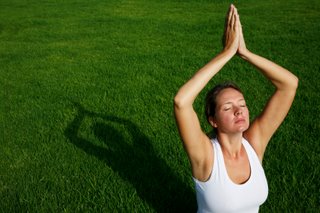
Outdoor Yoga
That most familiar of asana sequences, Surya Namaskar (Sun Salutation) is as rich in symbolic and mythic overtones as it is in physical benefits.
In many cultures, light has long been a symbol of consciousness and self-illumination. “The world begins with the coming of light,” wrote Jungian analyst Erich Neumann in The Origins and History of Consciousness (Princeton University Press, 1995). “Opposition between light and darkness has informed the spiritual world of all peoples and molded it into shape.”
Our primary source of light is, of course, the sun. When we look at our closest star, we may see nothing more than a big yellow ball. But for thousands of years, the Hindus have revered the sun, which they call Surya, as both the physical and spiritual heart of our world and the creator of all life itself. That’s why one of Surya’s many other appellations is Savitri (the Vivifier), who, according to the Rig Veda, “begets and feeds mankind in various manners” (III.55.19). Moreover, since everything that exists originates from the sun, as Alain DaniŽlou wrote in The Myths and Gods of India (Inner Traditions, 1991), it “must contain the potentiality of all that is to be known.” For the Hindus, the sun is the “eye of the world” (loka chakshus), seeing and uniting all selves in itself, an image of and a pathway to the divine.
One of the means of honoring the sun is through the dynamic asana sequence Surya Namaskar (better known as Sun Salutation). The Sanskrit word namaskar stems from namas, which means “to bow to” or “to adore.” (The familiar phrase we use to close our yoga classes, namaste—te means “you”—also comes from this root.) Each Sun Salutation begins and ends with the joined-hands mudra (gesture) touched to the heart. This placement is no accident; only the heart can know the truth.
The ancient yogis taught that each of us replicates the world at large, embodying “rivers, seas, mountains, fields…stars and planets…the sun and moon” (Shiva Samhita, II.1-3). The outer sun, they asserted, is in reality a token of our own “inner sun,” which corresponds to our subtle, or spiritual, heart. Here is the seat of consciousness and higher wisdom (jnana) and, in some traditions, the domicile of the embodied self (jivatman).
It might seem strange to us that the yogis place the seat of wisdom in the heart, which we typically associate with our emotions, and not the brain. But in yoga, the brain is actually symbolized by the moon, which reflects the sun’s light but generates none of its own. This kind of knowledge is worthwhile for dealing with mundane affairs, and is even necessary to a certain extent for the lower stages of spiritual practice. But in the end, the brain is inherently limited in what it can know and is prone to what Patanjali calls misconception (viparyaya) or false knowledge of the self.
The eight basic postures, in order of performance, are Tadasana (Mountain Pose), Urdhva Hastasana (Upward Salute), Uttanasana (Standing Forward Bend), Lunge, Plank Pose, Chaturanga Dandasana (Four-Limbed Staff Pose), Urdhva Mukha Svanasana (Upward-Facing Dog Pose), and Adho Mukha Svanasana (Downward-Facing Dog Pose).
The transition from posture to posture is facilitated by either an inhalation or an exhalation. As you move through the sequence, watch your breath closely. Slow your pace or stop and rest entirely if your breathing becomes labored or shuts down altogether. Always breathe through your nose, not your mouth: Nasal breathing filters and warms incoming air and slows your breathing down, thereby lending the sequence a meditative quality and reducing the risk of hyperventilation.
To perform the sequence, start in Tadasana, with your hands together at your heart. Inhale and lift your arms overhead to Urdhva Hastasana, then exhale while lowering the arms down and fold your torso into Uttanasana. Then inhale, arch your torso into a slight backbend with the fingertips or palms pressed to the floor or blocks, and exhale while bringing your left foot back into a lunge. Inhale forward to Plank, then exhale and lower yourself into Chaturanga Dandasana. On an inhalation, arch your torso up as you straighten your arms into Upward Dog. Exhale back to Downward Dog; step the left foot forward on an inhalation into Lunge. Swing the right leg forward to Uttanasana on an exhalation, then lift your torso and reach your arms overhead on an inhalation to Urdhva Hastasana. Finally, lower your arms on an exhalation and return to your starting point, Tadasana.
Remember, this is only a half-round; you’ll need to repeat the sequence, switching left to right and right to left to complete a full round. If you’re just starting out, it might help to work on the poses individually before you put them together. (Visit www.YogaJournal.com for more how-to information.)
adapted from Yoga Journal, by Richard Rosen
Use our unique “Zen Clock” which functions as a Yoga Timer. It features a long-resonating acoustic chime that brings your meditation or yoga session to a gradual close, preserving the environment of stillness while also acting as an effective time signal. Our Yoga Timer & Clock can be programmed to chime at the end of the meditation or yoga session or periodically throughout the session as a kind of sonic yantra. The beauty and functionality of the Zen Clock/Timer makes it a meditation tool that can actually help you “make time” for meditation in your life. Bring yourself back to balance.

Yoga timers from Boulder, Colorado
Now & Zen – The Yoga Timer Store
1638 Pearl Street
Boulder, CO 80302
(800) 779-6383
Posted in intention, Now & Zen Alarm Clocks, wake up alarm clock, Well-being, yoga, Yoga Timer, Yoga Timers by Now & Zen